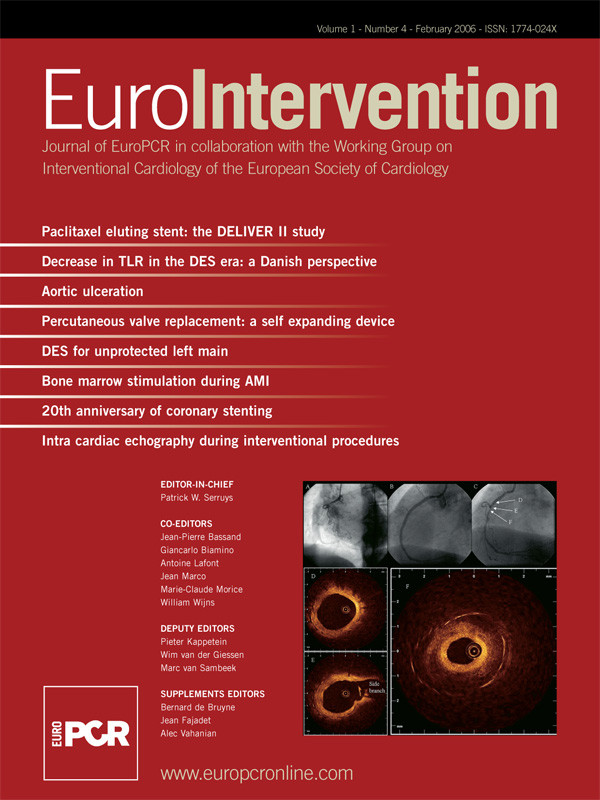Abstract
Aims: The purpose of this registry is to collect data on trends in interventional cardiology within Europe. Special interest focuses on relative increases and ratios in newer revascularization approaches and its distribution in different regions in Europe. We report the data of the year 2003 and give an overview of the development of coronary interventions since 1992, when the first data collection was performed.
Methods and results: Questionnaires were distributed yearly to delegates of all national societies of cardiology represented in the European Society of Cardiology to collect the case numbers of all local institutions and operators. The overall numbers of coronary angiographies increased from 1992 to 2003 from 684,000 to 1,993,000 (from 1,250 to 3,500 per million inhabitants). The respective numbers for percutaneous coronary interventions (PCI-coronary angioplasty) and coronary stenting procedures increased from 184,000 to 733,000 (from 335 to 1,300) and from 3,000 to 610,000 (from 5 to 1,100), respectively. Germany has been the most active country for the past years with 653,000 angiographies (7,800), 222,000 angioplasties (2,500), and 180,000 stenting procedures (2,200) in 2003. The indication has shifted towards acute coronary syndromes, as demonstrated by raising rates of interventions for acute myocardial infarction over the last decade. The procedures are more readily performed and safer, as shown by increasing rate of “ad hoc” PCI and decreasing need for emergency coronary artery bypass surgery (CABG). In 2003, use of drug-eluting stents had further increased. However, an enormous variability is reported with the highest rate in Portugal (55%).
Conclusion: Interventional cardiology in Europe is still expanding, mainly but not exclusively due to rapid growth in the eastern European countries. A number of new coronary revascularization procedures introduced over the years have all but disappeared. Only stenting has experienced an exponential growth. The same can be forecast for drug-eluting stenting.
Introduction
Few reliable data exist providing field trends in interventional cardiology1-4. The report on Interventional Cardiology in Europe in 2003 represents the 12th edition of yearly reports initiated in 19925-13. The aim of this report is to show trends in cardiac catheter interventions in Europe over the last ten years. It summarizes cardiac catheter interventions and gives an overview of specific interventional cardiologic activities in 29 countries of Europe, the majority of the members of the European Society of Cardiology.
Methods
A detailed questionnaire, together with instructions and examples for completion, was sent to the presidents or designated delegates of the national societies of cardiology represented in the European Society of Cardiology (32 countries). It was distributed nationwide to all facilities performing diagnostic or interventional cardiac catheterization. A summary data sheet, filled out by the national representatives, was used to report the nationwide data set and, for the first time, the possibility was offered to fill in the forms online using ESC Web services. Finally, the data were entered into the central database and analyzed. In the case of missing or incomplete data, the national representatives were repeatedly reminded. In June 2005, the registry was closed for the 2003 report. Sufficient data were reported from 29 of the 32 countries included in the survey, representing more than 570 million people.
Despite numerous reminders the following countries did not provide data for the year 2003, and data of the year 2002 were substituted for the report: Bulgaria, Ireland and Italy. Morocco reported only one centre. Prior to publication the manuscript was submitted to the country representatives to have the figures checked for accuracy. Definitions of pathologies and procedures as well as questionnaires were used according to previously published reports5-13.
Results
Coronary angiography
A total of 1,992,680 coronary angiograms were performed in Europe in 2003 (Figure 1).
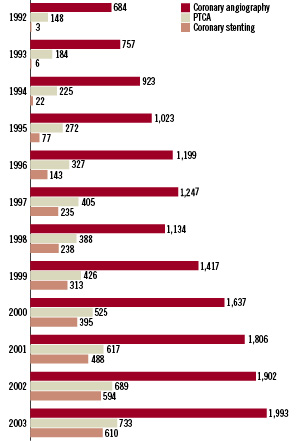
Figure 1. Coronary angiograms, coronary angioplasty (PCI), and coronary stenting from 1992 to 2003 in Europe in thousands of procedures.
This corresponds to an increase of 5% compared with 2002. In the ten year period from 1992 to 2003 a threefold increase of coronary angiograms occurred. In 2003, Germany reported the highest absolute and relative numbers, namely 652,781 angiograms or 7,780 per million inhabitants (Figure 2a).
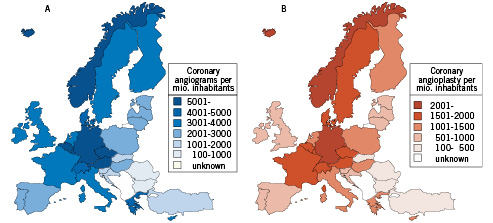
Figure 2. Cartographical illustrations of incidence of coronary angiograms (Panel A) and coronary angioplasty (PCI, Panel B) per million inhabitants in Europe in 2003.
This is a relative increase of 2% compared with 2002. Other central European countries reported varying variations in population-adjusted angiograms performed: Switzerland reported the highest rise with 17%, whereas Sweden, France and Luxembourg reported unchanged or even decreased numbers (from 0 to –6%). With the exception of Turkey (–18%), all countries of the eastern or southern Europe showed increases in angiograms per population. Slovenia reported the highest rise with 66%.
Coronary angioplasty
A total of 733,287 PCI procedures were reported for 2003, a 6% increase compared with 2002 (Figure 1). Compared with the first yearly survey in 1992 this constitutes a fivefold increase in percutaneous procedures. The mean population-adjusted number in 2003 was 1,283 procedures per 106 inhabitants, representing an increase of 5% compared with 2002. Germany reported with 221,867 PCI or 2,522 PCI per 106 inhabitants by far the highest numbers (Figure 2b). Norway was the only country with a population-adjusted PCI rate comparable with Germany with 2,380 procedures per 106 inhabitants. The smallest numbers of procedures per million people were reported from Romania (152) and Bulgaria (257). All countries reported relative increases in procedures. Some European countries were reporting the highest relative increase (Greece +70%, Slovakia +50%, Poland +50%, Hungary +46%).
The mean ratio of PCIs to coronary angiograms was 0.36 (2002: 0.35). The ratio of PCIs to coronary angiograms ranged from 0.23 in Turkey to 0.52 in France (Figure 3).
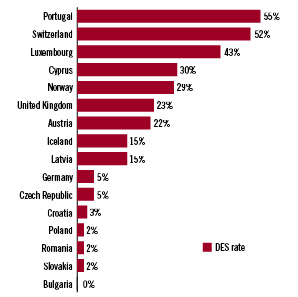
Figure 3. PCIs per coronary angiogram ratio in 2003 in Europe.
Multivessel interventions in one session were performed in 17% in 2003. In the ten year period there is no clear trend towards a relative increase in multivessel procedures (Figure 4a). Interventions for acute myocardial infarction in 2003 amounted to 17% of all coronary procedures. These numbers are comparable with those reported by the National Cardiovascular Data Registry of the American College of Cardiology for 1998 to 20013. The ten year overview shows an increase of interventions for acute myocardial infarction per PCI from 4% to 17% (Figure 4b).
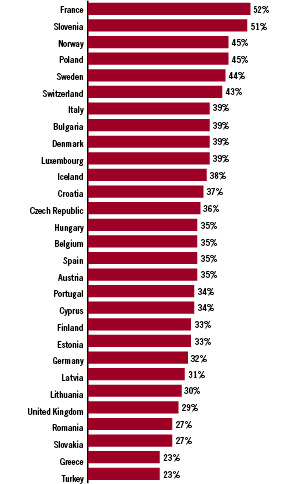
Figure 4. Drug-eluting stent rate in 2003 in Europe.
From 1992 to 2003 the share of ad hoc PCI procedures increased from about 25% to 56% (Figure 4c). The highest ad hoc-percentages were reported from Spain (98%).
Coronary stenting
Approximately 610,300 stenting procedures were reported in 2003 (Figure 1), resulting in an increase of 3% compared with 2002 (approximately 594,000 procedures). Stenting had been rare in 1992 with a total of 3,211 procedures (six per million). Stenting procedures tripled from 1993 to 1994, and quadrupled from 1994 to 1995. Since 1996 stenting procedures showed a mean yearly increase rate of 43%. Germany reported the highest absolute numbers for 2003 (179,650). The ratio of coronary stenting to PCI procedures averaged 0.83. Most countries reported ratios 0.70 or above. Drug eluting stents have been introduced in 2001. In 2003, 16 countries reported its use, which is continuously increasing. However, an enormous variability is reported with the highest rate in Portugal (55%) (Figure 5).

Figure 5. Percutaneous coronary intervention (PCI) rate for intervention on multiple vessels (Panel A), for acute myocardial infarction (AMI-Panel B), and “Ad hoc” PCI (Panel C) in Europe in 2003.
Other devices
Other therapeutic devices (directional atherectomy, rotablator, laser catheter or wire, ultrasound therapy, brachytherapy, clot catcher/ remover) were reported in a total of 20,670 cases in 2003 (See Table 1 for details).
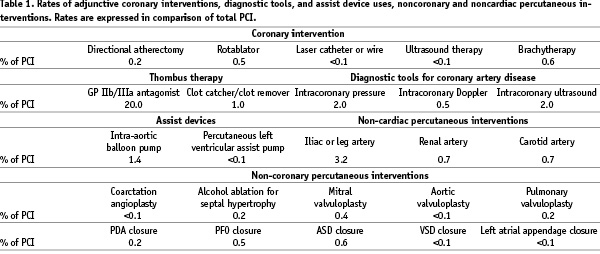
There were no sweeping changes over the last decade. The diagnostic tools intravascular ultrasound and intracoronary pressure measurements were the most often used addition to balloon and stent. Nonetheless they were used in only 2% of PCI procedures.
Complications
Death has remained virtually unchanged since 1992 and was reported in 0.6% in 2003. The need for emergency coronary artery bypass grafting (CABG) remained stable at 0.3%. The incidence of PCI-induced myocardial infarction was reported in 0.8%. This reflects respectively a ten- and twofold reduction of these relative incidences during the last decade (Figure 6).

Figure 6. Complication rates (%) of coronary interventions from 1992 to 2003 in Europe.
Catheterization facilities
According to the reported numbers, there was a mean of 2.6 cardiac catheterization facilities per 106 inhabitants in Europe (2.5 in 2002). The highest density existed in Iceland and Denmark (6.9 per 106), the lowest in Slovakia (1.1 per 106). A mean of 1,170 (556 to 1,870) coronary angiographies and 406 PCIs (211 to 801) were performed per catheterization room. The numbers of coronary angiographers per million people ranged between 2 in Romania and 32 in Belgium, and respective number of PCI operators from 1 in Romania to 16 in Austria.
Discussion
The information provided by the national societies of cardiology was voluntary and not scrutinised. No audit or quality control was performed other than having the compiled numbers reconfirmed by the country representatives. Therefore, the data are aggregated. Underreporting of complications is likely.
Pilot registries with real time case per case recording are in progress in Sweden and in a number of European reference institutions (initiative of working group 10 of the European Society of Cardiology). The idea is to extend that method of data collection to all invasive centers of the member countries. This will obviate the current reporting delay and guarantee accuracy of numbers. Including reliable hospital outcome data will require a second look data entry at discharge and audits for quality control. A conservative estimate is that the first step can be accomplished (continent-wide) within 5 years, the second needing another 5 years. For the interim, the quality of data collection presented here will have to do.
The overall numbers of coronary angiographies continue to increase throughout the European community. From 1992 to 2003, they passed from 1,250 to 3,500 per million inhabitants. The growth, however, has slowed down, which predicts a plateau phase. For the PCI procedures there is a marked difference between the various nations. Interestingly, Norway still reported a high rise in the PCI procedure-rate and is currently the runner-up to Germany.
The indication has shifted towards acute coronary syndromes, as demonstrated by raising rates of interventions for acute myocardial infarction over the last decade. The procedures are more readily performed and safer, as shown by increasing rate of “ad hoc” PCI and decreasing need for emergency CABG. The fact that the rate of multivessel angioplasty in a single session has remained stable below 20% in the past decade is somewhat at odds with the technical improvements that occurred during that time period and clearly against the general opinion. It may be partially due to staging multivessel procedures. Yet, technical improvements should have decreased staged procedures over time. Notwithstanding, the absolute number of multivessel PCi increased steadily, albeit commensurate with the numbers of single vessel PCI.
In 2003, the use of drug-eluting stents was further increasing. A large variability was reported with the highest rate in Portugal (55%). It remains to be seen if this new device will have a significant impact on the overall number of procedures in the next year and whether it impacts more on the number of complex or simple cases14.
Appendix
We express our thanks to all representatives of the national societies of cardiology and the local persons put in charge in the individual centres for their highly appreciated help with this data collection.
Message from the Working Group
The ESC Working Group on Interventional Cardiology (WG10) regularly publishes data on trends in interventional cardiology within Europe. Although the presentation of this data in this paper is somewhat delayed, it is of clinical and scientific importance. As discussed by the authors, pilot registries with real time case per case recording are in progress in Sweden and in a number of European reference institutions (an initiative of the WG10). The goal is to extend this method of data collection to all invasive centres of the member countries. This will curtail the current reporting delay and guarantee accuracy of the data. Finally the Working Group commends the authors for their work as this paper provides a good illustration of the breakthrough of percutaneous interventions in Europe during the last decade.
Antoine Lafont,
Chairman, Working Group on Interventional Cardiology of the European Society of Cardiology
